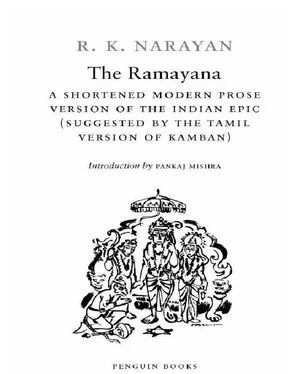Махариши Вальмики - The Ramayana
Здесь есть возможность читать онлайн «Махариши Вальмики - The Ramayana» весь текст электронной книги совершенно бесплатно (целиком полную версию без сокращений). В некоторых случаях можно слушать аудио, скачать через торрент в формате fb2 и присутствует краткое содержание. Жанр: Старинная литература, на английском языке. Описание произведения, (предисловие) а так же отзывы посетителей доступны на портале библиотеки ЛибКат.
- Название:The Ramayana
- Автор:
- Жанр:
- Год:неизвестен
- ISBN:нет данных
- Рейтинг книги:3 / 5. Голосов: 1
-
Избранное:Добавить в избранное
- Отзывы:
-
Ваша оценка:
- 60
- 1
- 2
- 3
- 4
- 5
The Ramayana: краткое содержание, описание и аннотация
Предлагаем к чтению аннотацию, описание, краткое содержание или предисловие (зависит от того, что написал сам автор книги «The Ramayana»). Если вы не нашли необходимую информацию о книге — напишите в комментариях, мы постараемся отыскать её.
The Ramayana — читать онлайн бесплатно полную книгу (весь текст) целиком
Ниже представлен текст книги, разбитый по страницам. Система сохранения места последней прочитанной страницы, позволяет с удобством читать онлайн бесплатно книгу «The Ramayana», без необходимости каждый раз заново искать на чём Вы остановились. Поставьте закладку, и сможете в любой момент перейти на страницу, на которой закончили чтение.
Интервал:
Закладка:
The many Ramayana s also reflect the ideologies of their time: like most influential literature, The Ramayana has never been exempt from the struggles for political power. This became clearer after the eighth century A.D. as small kingdoms arose in India, and rulers sought legitimacy through association with the cult of Rama, the supposedly ideal king (the practice continues in Thailand, where nine kings in the previous two centuries have called themselves Rama). Even during the long centuries of Muslim rule over India, people used The Ramayana to project the view of their particular social group. The Ramacharitamanas, the work of a North Indian Brahmin called Tulsi Das, laments the decay of caste hierarchy and the rise of low-caste men to positions of influence: a state of affairs that for Tulsi stands in distinctive contrast to the situation in the kingdom of Rama where everyone knew his place.
Not surprisingly, The Ramayana has invited its share of politically motivated critics. The South Indian activist E. V. Ramasami saw it as a tool of North Indian upper-caste domination. In an essay in 1989, the distinguished Indian historian Romila Thapar claimed that the televised Ramayana was an attempt to create a pan-Indian version for the more homogeneous modern age—one that India’s ambitious and politically right-wing middle class could easily consume. In retrospect, Thapar seems to have been proved right: the television serial’s immense popularity set the stage for the violent Hindu nationalist campaigns, in which Rama appeared as Rambo, his delicate features and gentle smile replaced by a muscular mien and grimace, and The Ramayana itself became a central text in the nationalists’ attempt to weld Hinduism’s plural traditions into a monotheistic religion.
R. K. Narayan was most certainly exposed to a benign version of The Ramayana in his childhood. He would have first imbibed it through the classical tradition of Carnatic music, the calendar-art images and gemstone-set portraits of Rama and Sita that are commonly found in bourgeois South Indian homes, and the great literary classic in the Tamil language, Kamba Ramayana .
But it took him some decades to get around to writing his own version of The Ramayana . Born in 1906 into a rising, urban family of Tamil Brahmins, which sought to enter, with one foot planted in tradition, the colonial Indian world of jobs and careers, Narayan had, as a young man, a bolder ambition than anyone around him could have possessed. He wanted to be a “realistic fiction writer” at a time when realistic fiction writers in English were almost entirely unknown in India. It is partly why he was, as he relates in his memoir, My Days (1974), indifferent to the classical Tamil literature his uncle wanted him to read.
Not surprisingly, Narayan wrote his abridged version of The Ramayana and The Mahabharata only in the seventies, after having produced some of his finest fiction: Swami and Friends (1935), The Financial Expert (1952), Waiting for the Mahatma (1955), The Guide (1958), and The Vendor of Sweets (1967). “I was impelled,” he once said, “to retell the Ramayana and the Mahabharata because that was the great climate in which our culture developed. They are symbolic and philosophical. Even as mere stories they are so good. Marvellous. I couldn’t help writing them. It was part of the writer’s discipline.” 2
The writerly compulsion Narayan expresses through his choice of words—“impelled,” “couldn’t help”—seems to have been greater than the one felt by a storyteller alighting upon good material. There is a mythic and religious dimension to Narayan’s later fiction, in which acts of personal devotion, self-effacement, and renunciation become a shield against the hard demands and uncertainties of the modern, impersonal world.
This religious aspect of Narayan is explicit in his Ramayana . His admiration for Rama as a cultural and social ideal is clear throughout the book. It leads him to preface his chapter on the controversial killing of the monkey king with these rueful words.
Rama was an ideal man, all his faculties in control in any circumstances, one possessed of an unwavering sense of justice and fair play. Yet he once acted, as it seemed, out of partiality, half-knowledge, and haste, and shot and destroyed, from hiding, a creature who had done him no harm, not even seen him. 3
Rama’s cruelty to Sita at the end of his battle with Ravana is one of the strangest episodes in The Ramayana —one which directly challenges Rama’s image as an exemplary moral being. In fact, the Tamil poet Kamban, Narayan’s literary inspiration, makes Rama say some unsettlingly harsh things to Sita.
You stayed content in that sinner’s city, enjoying your food and drink. Your good name was gone but you refused to die. How dared you think I’d be glad to have you back? 4
But Narayan drops Kamban’s account at this crucial moment in the book and chooses to bring in Valmiki’s much more moderate version of Rama’s decidedly odd behavior. It is as though he cannot fully acknowledge Rama’s lapse into cruelty, although such an omission may also be due to Narayan’s aversion to scenes of overt violence, verbal or physical—an aversion that his fiction with its careful avoidance of extremity makes clear.
Happily, Narayan doesn’t linger much over battle scenes, where his prose seems to be weighed down by untranslatable archaisms. The realistic fiction writer in him is more at ease with the detail of everyday life. Here is a description of the great crowd walking to attend Rama’s wedding.
Another young man could not take his eyes off the lightly covered breast of a girl in a chariot; he tried to keep ahead of it, constantly looking back over his shoulder, unaware of what was in front, and bumping the hindquarters of the elephants on the march. 5
Many of Narayan’s virtues familiar to us from his fiction are present in this retelling of The Ramayana —particularly an English prose so lucid and lightly inflected that it loses its foreign associations and seems the perfect medium of swift and action-packed storytelling. Indeed, The Ramayana contains some of Narayan’s finest prose set-pieces. Here is how he describes the end of the monsoons:
Peacocks came out into the sun shaking off clogging droplets of water and fanning out their tails brilliantly. Rivers which had roared and overflowed now retraced their modest courses and tamely ended in the sea. Areca palms ripened their fruits in golden bunches; crocodiles emerged from the depths crawling over rocks to bask in the sun; snails vanished under slush, and crabs slipped back under ground; that rare creeper known as vanji suddenly burst into bloom with chattering parrots perched on its slender branches. 6
And so instinctively scrupulous and fair-minded is Narayan as a writer that not only Rama but also Ravana emerges as a fully rounded, even somewhat sympathetic, character. Though a dedicated sensualist, Ravana does not seem intrinsically bad or evil. Narayan shows clearly how he is led astray by greed, and then succumbs to the particular illusion of power: the dream of perpetual dominance. As his younger brother, who defects to Rama’s side, tells him,
“You have acquired extraordinary powers through your own spiritual performances but you have misused your powers and attacked the very gods that gave you the power, and now you pursue evil ways. Is there anyone who has conquered the gods and lived continuously in that victory?” 7
How often in Narayan’s fiction does one come across a similar pragmatic realism, a gentle refusal to regard good and evil as unmixed, and a melancholy sense of the real limitations of life? It is this ethical and spiritual outlook that attracted countless people to The Ramayana for more than a millennium. In Narayan—the sage of Malgudi who always knew how to connect our hectic and fraught present to a barely remembered past—this ancient tale found its perfect modern chronicler.
Читать дальшеИнтервал:
Закладка:
Похожие книги на «The Ramayana»
Представляем Вашему вниманию похожие книги на «The Ramayana» списком для выбора. Мы отобрали схожую по названию и смыслу литературу в надежде предоставить читателям больше вариантов отыскать новые, интересные, ещё непрочитанные произведения.
Обсуждение, отзывы о книге «The Ramayana» и просто собственные мнения читателей. Оставьте ваши комментарии, напишите, что Вы думаете о произведении, его смысле или главных героях. Укажите что конкретно понравилось, а что нет, и почему Вы так считаете.












